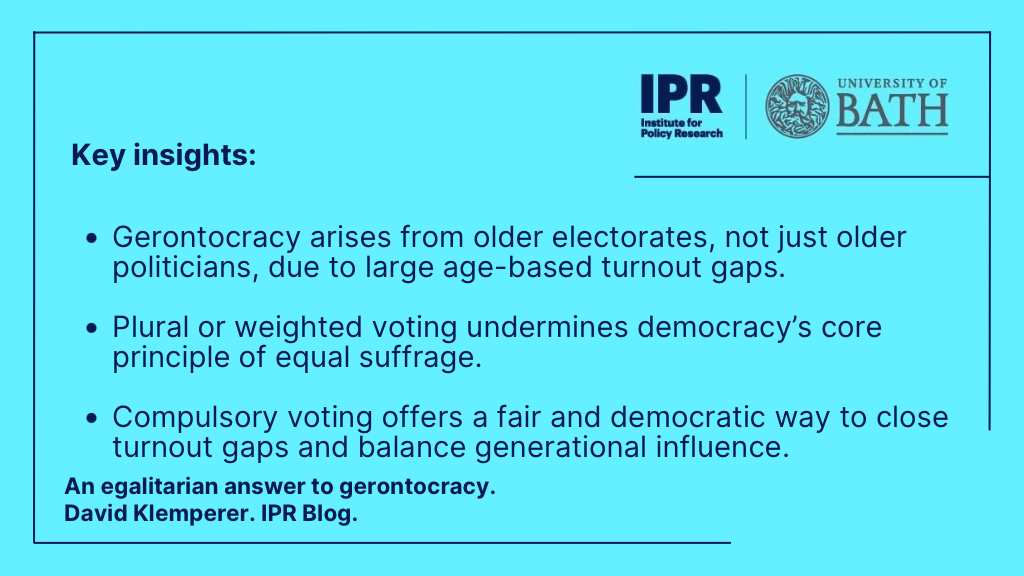Debates about gerontocracy often focus on the age of leaders, but the deeper issue lies in the age of electorates. Older citizens vote far more than the young, skewing democratic outcomes. This blog argues that rather than adopting unequal “plural voting,” democracies should embrace compulsory voting to ensure fair participation and balanced generational influence.
Before joining the IPR, Dr David Klemperer completed a PhD in History at Queen Mary University of London, exploring the intellectual development of social democratic politics in twentieth-century France. He has also previously been a Research Fellow at the Constitution Society (leading projects on turnout disparities and electoral reform), and a Research Assistant at the Institute for Government (analysing the Brexit process).
In a recent essay for Democracy Project, the American intellectual historian and public commentator Samuel Moyn provides previews some arguments from his forthcoming book on gerontocracy. Specifically, he posits that debates about “gerontocracy” need to look beyond the age of politicians, and instead attend to the age of democratic electorates. American elections, as he rightly observes, are skewed not only by a racial turnout gap, but also by an age-based turnout gap, with older citizens considerably more likely to vote than their younger compatriots.
In my own recent work for the Constitution Society, I pointed to the existence of a similar phenomenon in the UK: at the last general election in July 2024, the polling firm Ipsos estimated that those aged 65 and over were almost twice as likely to have voted as those aged under 25. This is not just a problem in principle: my report shows by giving politicians clear electoral incentives to disproportionately prioritise the preferences and interests of the elderly, the age-based turnout gap has distorted political and economic outcomes, contributing to high inequality, low economic growth, and rising dissatisfaction with democracy.
How then are such age-related turnout gaps to be combatted? Moyn’s suggestion for the US is that Americans should explore “some combination of proxy and weighted voting”. In other words, Moyn believes that to combat the electoral predominance of the elderly, extra votes should be granted to specific categories of voters – either to parents to be cast on behalf of their younger dependents, or to young voters themselves as a means of amplifying their own voting power.
What Moyn has essentially re-invented here is the old idea of “plural voting” – different forms of which existed in a number of European parliamentary systems in the nineteenth and early-twentieth centuries, and one version of which was famously advocated by the liberal political theorist John Stuart Mill in his 1859 book Considerations on Representative Government.
In a system with plural voting, certain electors are allowed to cast more than one vote. In the UK, extra ballots were available to university graduates and (some) business owners up until 1950. In Belgium prior to the First World War, electors could receive up to two additional votes on the basis of wealth, education, or being the head of a family. J.S. Mill’s proposal – made amidst the gradual extension of the franchise in Britain – was for different numbers of votes to be assigned to each elector on the basis of their intellect, as reflected primarily by their professional status.
As critics have long argued, the logic of plural voting is inherently anti-egalitarian and even anti-democratic, since it rejects the basis of democracy in the egalitarian principle of “one person, one vote” in favour of a sliding scale of electoral power. For the democratic notion of political equality, plural voting substitutes the elitist notion of externally-determined political virtue, in which some people’s political contributions are deemed to be of greater value. Moreover, with votes distributed unequally, elections cease to be about determining the will of the people, and instead become mechanisms for technocratically engineering particular kinds of political outcome.
Indeed, nineteenth-century advocates of plural voting were largely explicit about their anti-egalitarian suspicions of democracy: in the UK, Mill was clear that his advocacy of plural voting was based on a rejection of the notion of political equality, and a fear that in a democratic system working-class voters might use their numerical weight to enact what he called “class legislation”; in Belgium, plural voting was introduced alongside the expansion of the franchise as part of a political compromise, designed to prevent manhood suffrage from overly-empowering organised labour.
That Moyn should turn to the advocacy of plural voting as a solution to gerontocracy is therefore surprising, since it sits at odds with his track record of excoriating liberals for embracing institutional constraints on democratic egalitarianism. Moreover, it is all the more striking given the existence of an obvious egalitarian alternative of similar historic provenance – namely, compulsory voting.
First introduced in Belgium in 1893, and subsequently used in a wide range of other democracies, compulsory voting is the simplest and most straightforward method of combatting disparities in turnout. In countries in which it is currently used (such as Belgium, Chile, or Australia), all eligible voters are legally obliged to cast a ballot, on pain of a small (usually financial) penalty. The result of compulsory voting is that turnout becomes almost universal, significantly reducing turnout disparities across different demographic groups.
This resolves the problem of electoral gerontocracy: where compulsory voting is used, turnout amongst the young closely matches turnout amongst the old, meaning the electorate as a whole is younger (in the recent Australian election for instance, Millennials and Gen-Z formed the largest generational voting bloc). This in turn shapes the incentives facing politicians, pushing them to take greater account of the preferences and interests of young voters.
Crucially however, compulsory voting does this while upholding the egalitarian principle of “one person, one vote”. Rather than responding to unequal voting patterns by abandoning the notion of political equality in the name of better outcomes, compulsory voting seeks to make real the egalitarian promise of universal suffrage, by ensuring that equal rights to participate in theory are matched by equal participation in practice.
Moyn is thus right to argue that Americans should seek to “vote their way out of gerontocracy”. He is wrong, however, to suggest that this should mean abandoning the principle of equal suffrage. Rather, “voting their way out of gerontocracy” should mean Americans embracing compulsory voting to overcome the age-based turnout gap by ensuring that the theoretical equality implied by equal voting rights is translated into substantive equality at the ballot box itself.
All articles posted on this blog give the views of the author(s), and not the position of the IPR, nor of the University of Bath.
Respond





